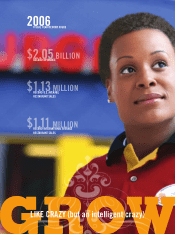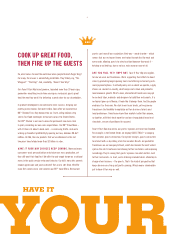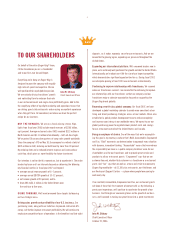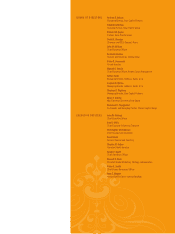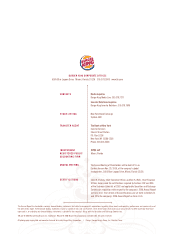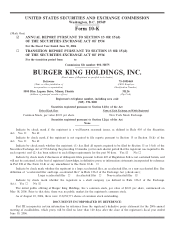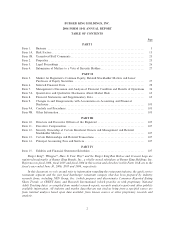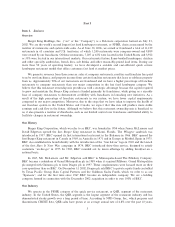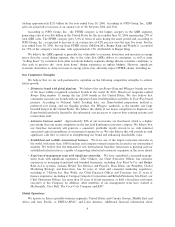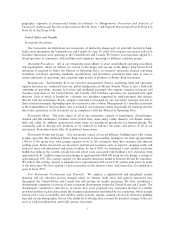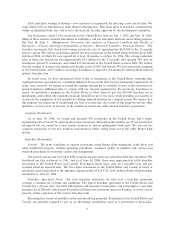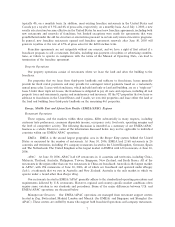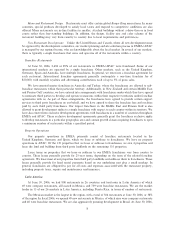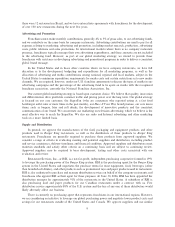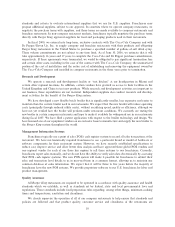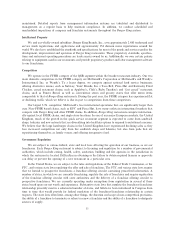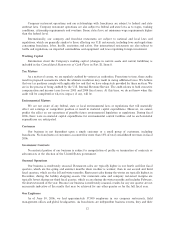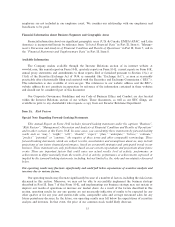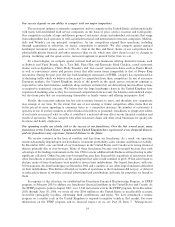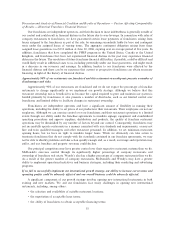Burger King 2006 Annual Report Download - page 17
Download and view the complete annual report
Please find page 17 of the 2006 Burger King annual report below. You can navigate through the pages in the report by either clicking on the pages listed below, or by using the keyword search tool below to find specific information within the annual report.geographic segments is incorporated herein by reference to Management's Discussion and Analysis of
Financial Condition and Results of Operations in Part II, Item 7 and Segment Reporting in Part II, Item 8 in
Note 20 of this Form 10-K.
United States and Canada
Restaurant Operations
Our restaurants are limited-service restaurants of distinctive design and are generally located in high-
traffic areas throughout the United States and Canada. At June 30, 2006, 878 company restaurants and 6,656
franchise restaurants were operating in the United States and Canada. We believe our restaurants appeal to a
broad spectrum of consumers, with multiple meal segments appealing to different customer groups.
Operating Procedures. All of our restaurants must adhere to strict standardized operating procedures
and requirements, which we believe are critical to the image and success of the Burger King brand. Each
restaurant is required to follow the Manual of Operating Data, an extensive operations manual containing
mandatory restaurant operating standards, specifications and procedures prescribed from time to time to
assure uniformity of operations and consistent high quality of products at Burger King restaurants.
Management. Substantially all of our executive management, finance, marketing, legal and operations
support functions are conducted from our global headquarters in Miami, Florida. There is also a field staff
consisting of operations, training, real estate and marketing personnel who support company restaurant and
franchise operations in the United States and Canada. Our franchise operations are organized into eight
divisions, each of which is headed by a division vice president supported by field personnel who interact
directly with the franchisees. Each company restaurant is managed by one restaurant manager and one to
three assistant managers, depending upon the restaurant's sales volume. Management of a franchise restaurant
is the responsibility of the franchisee, who is trained in our techniques and is responsible for ensuring that the
day-to-day operations of the restaurant are in compliance with the Manual of Operating Data.
Restaurant Menu. The basic menu of all of our restaurants consists of hamburgers, cheeseburgers,
chicken and fish sandwiches, breakfast items, french fries, onion rings, salads, desserts, soft drinks, shakes,
milk and coffee. In addition, promotional menu items are introduced periodically for limited periods. We
continually seek to develop new products as we endeavor to enhance the menu and service of all of our
restaurants. Franchisees must offer all mandatory menu items.
Restaurant Design and Image. Our restaurants consist of several different building types with various
seating capacities. The traditional Burger King restaurant is free-standing, ranging in size from approximately
1,900 to 4,300 square feet, with seating capacity of 40 to 120 customers, drive-thru facilities and adjacent
parking areas. Some restaurants are located in institutional locations, such as airports, shopping malls, toll
road rest areas and educational and sports facilities. In fiscal 2005, we developed a new, smaller restaurant
model that reduces the current average non-real estate costs associated with building a new restaurant from
approximately $1.2 million using the prior design to approximately $900,000 using the new design, a savings of
approximately 25%. The seating capacity for this smaller restaurant model is between 40 and 80 customers.
We believe this seating capacity is adequate since approximately 60% of our U.S. system-wide sales are made
at the drive-thru. We have opened 11 new restaurants in this format to date, with more than 10 scheduled to
open in fiscal 2007.
New Restaurant Development and Renewals. We employ a sophisticated and disciplined market
planning and site selection process through which we identify trade areas and approve restaurant sites
throughout the United States and Canada that will provide for quality expansion. We have established a
development committee to oversee all new restaurant development within the United States and Canada. The
development committee's objective is to ensure that every proposed new restaurant location is carefully
reviewed and that each location meets the stringent requirements established by the committee, which include
factors such as site accessibility and visibility, traffic patterns, signage, parking, site size in relation to building
type and certain demographic factors. Our model for evaluating sites accounts for potential changes to the site,
such as road reconfiguration and traffic pattern alterations.
5


